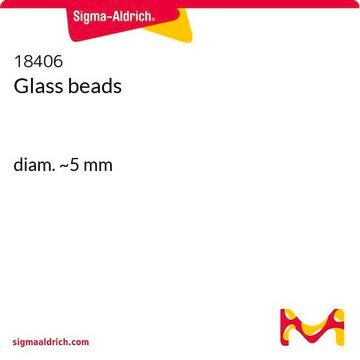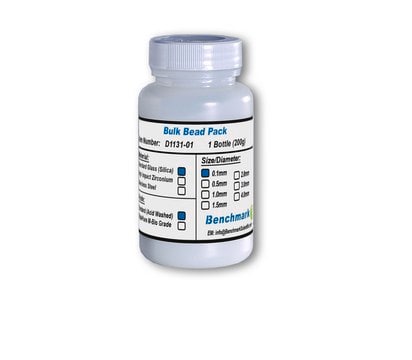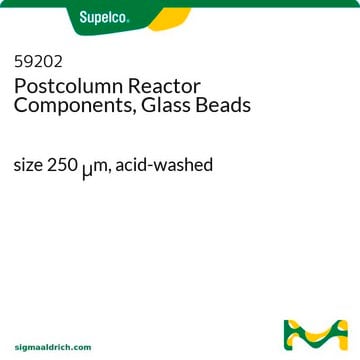Z250465
Glas-Beads
diam. 0.5 mm, for Mini-Beadbeater
Anmeldenzur Ansicht organisationsspezifischer und vertraglich vereinbarter Preise
Alle Fotos(1)
About This Item
UNSPSC-Code:
12000000
NACRES:
SB.32
Empfohlene Produkte
Durchmesser
0.5 mm
Suchen Sie nach ähnlichen Produkten? Aufrufen Leitfaden zum Produktvergleich
Allgemeine Beschreibung
Glass has a density of 2.5 g/cc and is the most commonly used bead media for ′Beadbeating′. Beads are sold in one pound bottles.
Anwendung
- Extraction of Diatom DNA from Water Samples and Tissues.: This study details a method for extracting DNA from diatom samples using glass beads to enhance the mechanical disruption of cell walls, facilitating the efficient recovery of high-quality DNA for downstream applications (Zhou YC et al., 2023).
- Combination of direct boiling and glass beads increases the purity and accuracy of bacterial DNA extraction.: The research presents an improved bacterial DNA extraction technique combining direct boiling with glass beads, resulting in higher purity and accuracy of the extracted DNA, which is crucial for precise molecular analyses (Li S et al., 2023).
- Solvent Precipitation SP3 (SP4) Enhances Recovery for Proteomics Sample Preparation without Magnetic Beads.: The study explores the use of solvent precipitation SP3 with glass beads, offering an efficient alternative for proteomics sample preparation, yielding better protein recovery compared to magnetic beads (Johnston HE et al., 2022).
- Efficient isolation of brain capillary from a single frozen mouse brain for protein expression analysis.: This research demonstrates an optimized method for isolating brain capillaries from frozen mouse brains using glass beads, enabling detailed protein expression analysis critical for neuroscience research (Ogata S et al., 2021).
Analysenzertifikate (COA)
Suchen Sie nach Analysenzertifikate (COA), indem Sie die Lot-/Chargennummer des Produkts eingeben. Lot- und Chargennummern sind auf dem Produktetikett hinter den Wörtern ‘Lot’ oder ‘Batch’ (Lot oder Charge) zu finden.
Besitzen Sie dieses Produkt bereits?
In der Dokumentenbibliothek finden Sie die Dokumentation zu den Produkten, die Sie kürzlich erworben haben.
Kunden haben sich ebenfalls angesehen
Yanjie Liu et al.
Yeast (Chichester, England), 37(3), 269-279 (2020-01-22)
In Saccharomyces cerevisiae under conditions of nutrient stress, meiosis precedes the formation of spores. Although the molecular mechanisms that regulate meiosis, such as meiotic recombination and nuclear divisions, have been extensively studied, the metabolic factors that determine the efficiency of
Vanessa David-Vaizant et al.
Frontiers in microbiology, 9, 2235-2235 (2018-10-16)
Wine biological aging is characterized by the development of yeast strains that form a biofilm on the wine surface after alcoholic fermentation. These yeasts, known as flor yeasts, form a velum that protects the wine from oxidation during aging. Thirty-nine
Unser Team von Wissenschaftlern verfügt über Erfahrung in allen Forschungsbereichen einschließlich Life Science, Materialwissenschaften, chemischer Synthese, Chromatographie, Analytik und vielen mehr..
Setzen Sie sich mit dem technischen Dienst in Verbindung.











